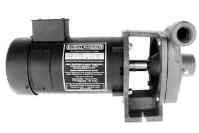
SunCentric
The SunCentricTM uses solar-electric power to pump as
much as 50,000 gallons (200 cu. m.) per day from shallow water sources.
Applications include irrigation, livestock,
domestic water, pond management, water treatment, solar water heating,
hydronic space heating, fire protection, and more.
These pumps have been in worldwide use since 1989. They can be used
without batteries. Maximum suction lift is
10 vertical feet (3 m).
- PV Array-Direct Application
- A PV-direct system uses water storage instead of
batteries. This is the simplest and most durable system for most
applications.
- A pump controller (linear current booster) is not
required.
- A solar tracker (optional) will help to maintain
optimum flow through the entire solar day.
- Storage of 3-7 days’ water demand is recommended.
- Optimum for circulation of solar-heated water.
- Selecting a Pump
- Select the appropriate chart of "PV Array-Direct
Applications" or "Battery Applications".
- Total Dynamic Head = Vertical distance from surface of
the
water source to the discharge or top of storage tank + pipe friction
losses.
- Use the solid line grid for English units. Use broken
line grid for metric units.
- Locate the coordinates for the required head and flow.
- Find the pump curve that is nearest to that point.
- If there is more than one curve to chose from, compare
the
power requirements. If PV-direct, the curve that goes higher will work
better during low sun intensity.
- For PV-Direct systems, array size (watts) is critical.
Do not undersize the array. Oversizing will improve performance in
low
sunlight conditions.
- Multiple pumps can be used to provide greater flow.
- Suction Capacity
- Suction limit is 10 vertical feet (3 m) at sea
level-subtract 1 foot for every 1000 ft. elevation (1 m per km).
- For best reliability, minimize or eliminate suction
lift by
placing the pump low and close to the water source. This will minimize
the possibility of cavitation which causes excessive wear and loss of
performance.
|
 EcoVantage Mobile Catalog
EcoVantage Mobile Catalog



